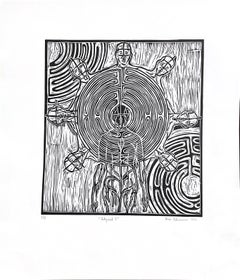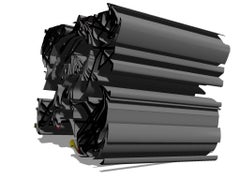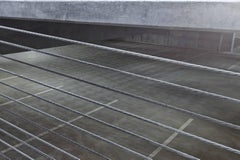Kimi Salamonova
Slovak, b. 2002
Kimi is a young emerging artist - starting her career at the Department of Graphics at the University of Fine Arts in Bratislava. Coming from an artistic family she is continuing in the family foot-steps. She loves to draw and always looking for creative solutions.(Biography provided by SalamonArt)
to
6
9
9
Purple Circles Photography Limited Signed
Located in Slovak Republic, SK
Abstract photography, very vivid colors, limited to 10, signed by the author. Evoking happiness and good mood.
Category
21st Century and Contemporary Abstract Kimi Salamonova
Materials
Photographic Paper
Labyrint. V. / Linocut / Edition 2/10 signed
Located in Slovak Republic, SK
Linocut, signed by the author, from the series " Where we are Heading?"
Category
21st Century and Contemporary Abstract Kimi Salamonova
Materials
Linocut
Labyrint I. / Linocut / Edition 2/6 and signed
Located in Slovak Republic, SK
Labyrint I. linocut, edition 2/6 signed by the author from series " Where we are Heading?"
Category
21st Century and Contemporary Abstract Kimi Salamonova
Materials
Linocut
Very Black, 3D Animation, Fine Art Print, Limited
Located in Slovak Republic, SK
Fine Art Print, limited 10, signed by the author.
Category
21st Century and Contemporary Abstract Kimi Salamonova
Materials
Black and White
What is This? Fine Art Print Limited Edition
Located in Slovak Republic, SK
Limited edition of 5, signed by the author.
Category
21st Century and Contemporary Kimi Salamonova
Materials
Color, Digital
Sans Titre Illustration Print Limited Edition Signed
Located in Slovak Republic, SK
Print/ Photography/ Limited edition of 15, proposal for a Vinyl cover, signed by the author.
Category
21st Century and Contemporary Modern Kimi Salamonova
Materials
Digital, Color, Archival Pigment
Bowing Man I.
Located in Slovak Republic, SK
Lino-cut, edition 50, homage to the grand-father of the author, could be delivered in different colors, signed by the author.
Category
21st Century and Contemporary Abstract Kimi Salamonova
Materials
Color, Linocut
Three chestnut horses
Located in Slovak Republic, SK
Lino-cut, edition 50, could be delivered also in different colors. Each Lino-cut is unique due to the method used. Three chestnut horses is inspired by ...
Category
21st Century and Contemporary Abstract Kimi Salamonova
Materials
Adhesive, Color, Archival Pigment
She and he
Located in Slovak Republic, SK
Lino-cut, edition 50, hommage to grandpa and grandma. Could be delivered in different colours and framing optio s avaialable.
Category
21st Century and Contemporary Kimi Salamonova
Materials
Black and White, Archival Pigment
Related Items
Honesty in a Pink Vase and Marguerites in a Green Jug diptych
By Amy Christie
Located in Deddington, GB
Honesty in a Pink Vase and Marguerites in a Green Jug diptych
Overall size cm : H120 x W120
Honesty in a Pink Vase by Amy Christie is a limited edition pri...
Category
2010s Contemporary Kimi Salamonova
Materials
Paper, Giclée
H 23.63 in W 23.63 in D 0.04 in
Concrete ( 48 x 72" / 122 x 183cm )
By Frank Schott
Located in San Francisco, CA
Concrete by Frank Schott
monochromatic details of architecture
48 x 72 inches / 122cm x 183cm
edition of 7
signed
27 x 40 inches / 68cm x 102cm
edition of 25
signed
archival fine ...
Category
21st Century and Contemporary Abstract Kimi Salamonova
Materials
Archival Ink, Archival Paper, Photographic Paper, Archival Pigment, Giclée
Kitchen Cat, Digital Painting Print, Interiors, Still Life, Fruit Bowl, Yellow
Located in Jersey City, NJ
"Kitchen Cat" by Molly Craig
2021
Digital painting print, interiors, still life, animal, cat art, figurative, emerging artist; yellow kitchen with black an...
Category
21st Century and Contemporary Contemporary Kimi Salamonova
Materials
Digital, Archival Ink, Archival Paper, Archival Pigment
The Sun Tree Limited Edition Lithograph after Dali
By (after) Salvador Dali
Located in Cirencester, Gloucestershire
'Sun tree lithograph'
After Salvador Dali (1904 - 1989)
signed print on thick paper , unframed
print: 16 x 12.5 inches
provenance: private collection
condition: very good and sound c...
Category
20th Century Abstract Kimi Salamonova
Materials
Color
Swirling Plants & Animals Limited Edition Lithograph after Dali
By (after) Salvador Dali
Located in Cirencester, Gloucestershire
After Salvador Dali (1904 - 1989)
limited edition lithograph, on thick paper, unframed
print: 16 x 12.5 inches
provenance: private collection, France
condition: very good and sound ...
Category
20th Century Abstract Kimi Salamonova
Materials
Color
Kerry Day, Swiss Cheese Plant, Limited Edition Print, Floral Art, Bright Art
By Kerry Day
Located in Deddington, GB
Kerry Day
Swiss Cheese
Limited Edition 7 Layered Linocut Print
Edition of 10
Image Size: H 30.4cm x W 30.5cm
Sheet Size: H 43cm x W 42cm x D 0.1cm
Sold Un...
Category
21st Century and Contemporary Abstract Geometric Kimi Salamonova
Materials
Paper, Linocut
Free Shipping
H 16.93 in W 16.54 in
California Abstract Expressionist Linocut Lithograph Sepia Print Edition of 6
By Hans Burkhardt
Located in Surfside, FL
Untitled, 1983, lithograph printed in sepia ink,
Hand signed and dated lower right, numbered in pencil with the artist's chop mark lower left, inscribed
by artist. From a series of experimental abstract linocuts done in 1983. These are very small editions and were gifted to a friend of the artist. They are done on deckle edged French Arches Art paper.
Hans Gustav Burkhardt (1904 – 1994) was a Swiss-American abstract expressionist artist.
Hans Burkhardt was born in the industrial quarter of Basel, Switzerland. Captivated by Germanic art, he began dabbling in art in his spare time while learning how to decorate furniture in antique styles. He became foreman of the furniture company's decorating department. From 1925 to 1928 he attended the Cooper Union School of the Arts, where he befriended mentor Arshile Gorky and Willem de Kooning—sharing Gorky's studio from 1928 to 1937.
Burkhardt's paintings of the 1930s are part of the genesis of American abstract expressionism. In 1937 he moved to Los Angeles and represented the most significant bridge between New York and Los Angeles. His experimental investigative approach paralleled, and in many instances anticipated, the development of modern and contemporary art in New York and Europe including the work of Mark Rothko, Jackson Pollock, and Barnett Newman.
Burkhardt held his first solo exhibition in 1939 at Stendahl Gallery in Los Angeles, arranged by Lorser Feitelson, and, in response to the Spanish Civil War, he painted his first anti-war works. From the late 1930s he began to produce apocalyptic anti-war compositions, a theme which became particularly pronounced in an abstract expressionist style after the atom bomb was dropped on Hiroshima and Nagasaki at the end of the Second World War. In the years following an acclaimed (1945) solo exhibition at the Los Angeles County Museum, Burkhardt continued in his art to respond to WWII, in the aftermath of Gorky's suicide in 1948, Burkhardt delved into his grief and celebration of Gorky's life creating several versions of “Burial of Gorky” and a series entitled “Journey into the Unknown.” Burkhardt first visited Mexico in 1950, and spent the next decade living half of the year in and around Guadalajara. Strongly influenced by Mexican attitudes towards the dead, and by the country's colors, sensuality, and spiritual qualities, Burkhardt “painted the soul of Mexico” with Mexican themes and colors—especially those of burials and ceremonies surrounding death—permeating his abstract work. His Mexican work flirted with Surrealism although he was never really considered a Surrealist artist. Art critics of the time considered him a "great Mexican master” alongside Orozco, Diego Rivera, and Siqueiros, and Rufino Tamayo admired his work. Overall, in the 1950s Burkhardt held 23 solo exhibitions in Los Angeles and Mexico, and participated in group shows at over thirty museums worldwide. He was friends with June Wayne from Tamarind Press.
In the 1960s he produced paintings in protest against the Vietnam War, some of which incorporated the human skulls he had collected from Mexican graveyards. As art historian Donald Kuspit stated, Burkhardt was “a master—indeed the inventor—of the abstract memento mori.” In 1964, for the first time in forty years, Burkhardt returned to Basel, and began making annual summer visits where he became a friend of Mark Tobey—printing linocuts for the artist and collecting his work. In the 1970s Burkhardt continued his anti-war paintings—incorporating protruding wooden spikes into the canvas—while simultaneously painting abstractions of merging lovers and cityscapes during his summer visits to Basel. His “Small Print” (protesting smoking), “Graffiti,” and “Northridge” series demonstrate the evolution of his symbolism, and his “Desert Storms” series, in response to Iraq's invasion of Kuwait, was discussed by critic Peter Selz at a presentation at the International Congress of Art Critics Conference.
In the last decades of his life, Burkhardt's work had moved from images of imbalance to a study of human tragedy—which he embraced in an attempt to discover beauty and facilitate understanding. Critic Peter Frank called Burkhardt “…one of America’s most vital abstract expressionist painters, someone who took the seed of the movement and cultivated it a rather different way in very different soil.”
Burkhardt taught at numerous colleges and universities and retired as a professor emeritus from California State University, Northridge. In 1992 Burkhardt was honored as the recipient of the Lifetime Achievement Award by the American Academy and Institute of Arts and Letters’ Jimmy Ernst (son of Max Ernst) Award. Also in 1992, he established the Hans G. and Thordis W. Burkhardt Foundation. In 1993, the last year of his career, his final series “Black Rain” channeled pain and hardship, but provided poignant, symbolic beacons of hope and wishes for a better future for humanity. His unique role as an important American painter is affirmed by the constant interest and continuing reassessment afforded his work.
Select Solo exhibitions
1939: Stendahl Gallery, Los Angeles, March 27 – April 17
1945: Hans Burkhardt, Los Angeles County Museum of Art
1951: Museo de Bellas Artes, Guadalajara, Mexico: Exhibición de Pinturas Modernas; Comara Gallery, Los Angeles
1953: Fisher Gallery, University of Southern California, Los Angeles
1957: Pasadena Art Museum, California: Ten Year Retrospective, June 14 – July 14;
1968: San Diego Museum of Art: Vietnam Paintings...
Category
1980s Abstract Expressionist Kimi Salamonova
Materials
Lithograph, Linocut
Joan Miro - Original Abstract Lithograph
By Joan Miró
Located in Collonge Bellerive, Geneve, CH
Joan Miro Miro Original Abstract Lithograph
Artist: Joan Miro
Medium: Original lithograph on Rives vellum
Portfolio: Miro Lithographe II
Year: 1975
Editi...
Category
1970s Abstract Kimi Salamonova
Materials
Lithograph
1940's Abstract Composition Jazz Lithograph Pencil Signed and Dated WPA Artist
By Konrad Cramer
Located in Surfside, FL
Konrad Cramer, 1888-1963 was a painter, photographer, printer, and illustrator.
Based in the fertile Woodstock, New York, artistic community along with Yasuo Kuniyoshi and Russell Lee, Cramer was both educator and artist. He ran a summer school for miniature camera photography in the 1930s and later taught one of the first American college courses in photography at Bard College. Although he began as a painter of abstract, geometric forms in bold colors, Cramer is most known as a photographer.
Konrad Cramer was born and raised in Wurzburg, Germany. Cramer studied to be an artist at the Karlsruhe Academy under Ludwig Schmidt-Reutte and Ernest Schurth. He became interested in the German avant-garde early in his schooling, he was a member of the Blaue Reiter, exposed and encouraged by the experimental works of Wassily Kandinsky and Franz Marc. An additional influence on Cramer's artistic development was the Cubist landscapes of Paul Cézanne.
Florence Ballin Cramer opened a gallery on 57th Street in 1919, encouraged by the sculptor Elie Nadelman. Florence Gallery exhibited and sold the works of living artists. Although it only survived briefly, it was the first New York gallery to show works by Yasuo Kuniyoshi, Alexander Brook, Ernest Fiene, and Stefan Hirsch. Cramer then settled with his wife in Woodstock, New York, where Ballin had painted with the Art Students League each summer since 1906. Cramer established a reputation as one of Woodstock's most modern painters with an impressive series of abstract paintings exhibited at the MacDowell Club in 1913. In the 1920s Cramer developed a personal representational style which blended modern and regional influences. Cramer received a Rockefeller grant in 1920 to study educational methods for craftsmen in Germany and France. In 1922 he took a teaching position at the Woodstock School of Painting and helped establish the Woodstock Artists Association, where he served as a director. While teaching and painting, Cramer also applied his artistic talent to illustration and textile design.
Konrad Cramer first exhibited at the Whitney Studio Club in 1924 and participated in the Whitney Museum of American Art's first and second biennials in 1933 and 1935. He was also included in the 1935 exhibition Abstract Painting in America at the Whitney. Cramer was later included in the Whitney Museum exhibition Pioneers of Modern Art in America in 1946. In the 1930s Cramer participated in many other museum invitationals, including: the Carnegie International (1929, 1933, 1937, 1938); the Pennsylvania Academy of the Fine Arts (1934, 1936), and the Corcoran Gallery of Art (1935, 1937).
In 1934 Konrad Cramer and his wife travelled to Mexico where they produced many paintings and drawings. Back in Woodstock in 1935, Cramer briefly joined the (WPA) Federal Art Project, administering the regional program in Woodstock. In the mid-1930s Cramer took up photography to clarify aesthetic issues in his painting. Cramer had gotten to know Alfred Stieglitz upon his arrival in America in 1911 and wrote an essay about 291 Gallery for Stieglitz's magazine Camera Work in 1914. Through Stieglitz and then in the 1930s fellow Woodstockers like Russell Lee, Cramer became interested in the possibilities of photography and began working with it as an artistic medium. In the 1950s Cramer collaborated on a traveling exhibition and book of abstract photographs with Manuel Komroff...
Category
1940s Abstract Kimi Salamonova
Materials
Lithograph
'Segments' — 1930s Geometric Abstraction
By Josef Albers
Located in Myrtle Beach, SC
Josef Albers, 'Segments', linoleum cut, 1934, edition 20, 25, plus proofs, Danilowitz 79. Signed, titled, dated, and annotated '(proof)' in pencil. A fine, richly-inked impression on...
Category
1930s Abstract Geometric Kimi Salamonova
Materials
Linocut
Red Skies, Limited Edition, Giclee print, red, abstract
By Harriet Hoult
Located in Deddington, GB
About this work of Art
‘Red Skies’ by Harriet Hoult.
This is a signed, Limited Edition Giclée print of the original painting by Harriet Hoult. The print is on a high grade, cold pres...
Category
2010s Kimi Salamonova
Materials
Giclée, Paper
"Sit and LIsten", abstract, turntable, cassette, tape, modern, chair, monoprint
By Patty deGrandpre
Located in Natick, MA
Deconstructed and cropped images of a turntable, a cassette tape, and a mid century modern chair are represented on 12 x 12 inch Red River photo paper in v...
Category
2010s Contemporary Kimi Salamonova
Materials
Paper, Color, Digital
Kimi Salamonova art for sale on 1stDibs.
Find a wide variety of authentic Kimi Salamonova art available for sale on 1stDibs. If you’re browsing the collection of art to introduce a pop of color in a neutral corner of your living room or bedroom, you can find work that includes elements of yellow and other colors. You can also browse by medium to find art by Kimi Salamonova in archival pigment print, linocut, pigment print and more. Much of the original work by this artist or collective was created during the 21st century and contemporary and is mostly associated with the abstract style. Not every interior allows for large Kimi Salamonova art, so small editions measuring 9 inches across are available. Kimi Salamonova art prices can differ depending upon medium, time period and other attributes. On 1stDibs, the price for these items starts at $96 and tops out at $1,202, while the average work can sell for $273.



